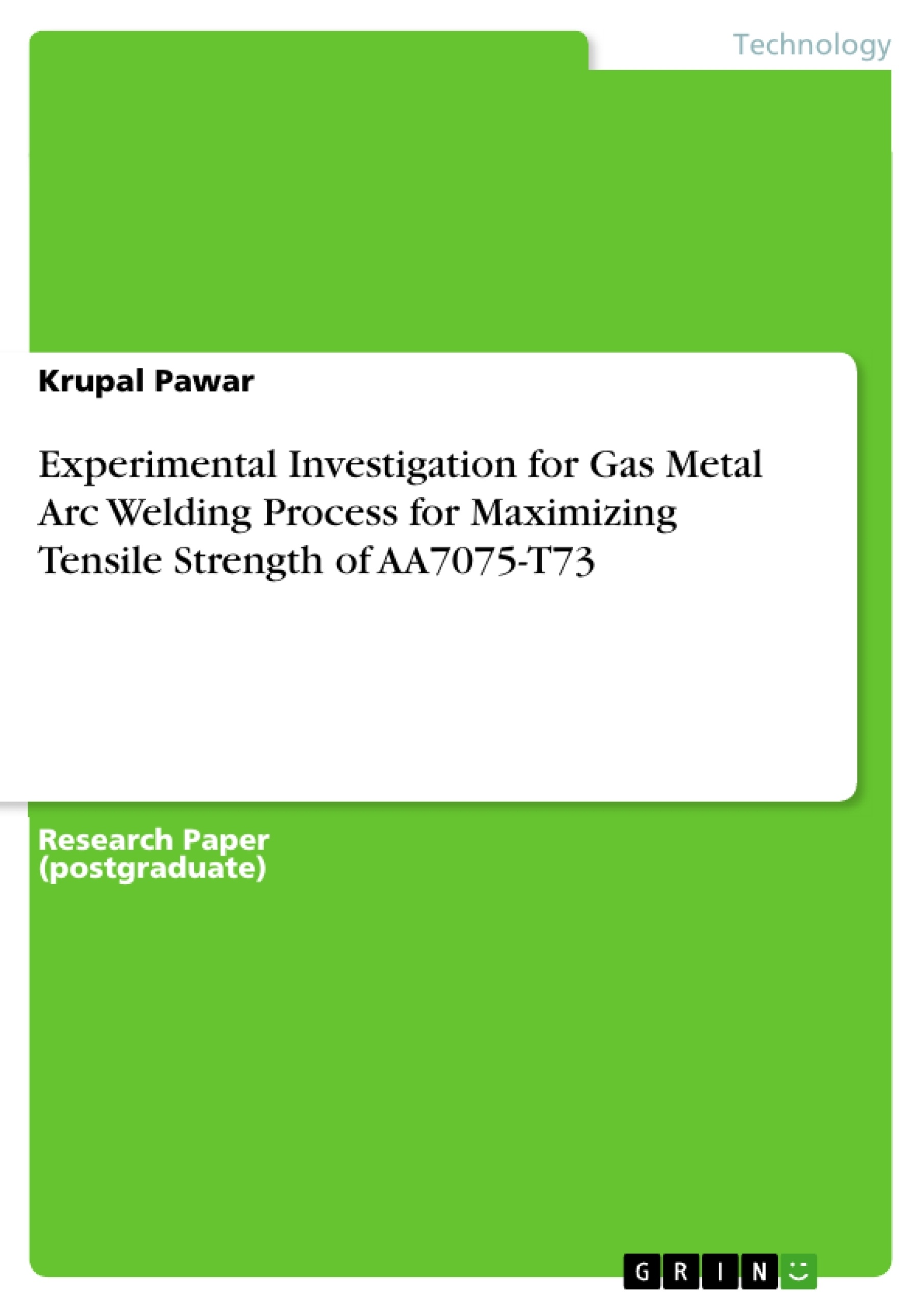In this paper, experimental investigation is carried out for Gas Metal Arc welding process for optimizing the tensile vigor of Aluminium Alloy7075-T73.This is arduous to weld Aircraft material utilizing Gas Metal Arc welding process. In this paper the L9 orthogonal array is employed to design the experiments. The experimentation was carried out in Ador Welding Ltd. Pune and the tensile vigor was quantified utilizing Macrocosmic Testing Machine (UTM) at the Sharadchandra Pawar College of Engineering, Otur, workshop.
The cull of erroneous parameters for welding may hazardous to the whole process and positions. This paper proposes and demonstrates the Taguchi’s Method for evaluating the performance measures of GMAW process. The input parameters such as current (Amp), Voltage (V0), welding speed (mm/min) and gas flow rate (Lit/min) are considered for study with tensile vigor as replication factor. The result of the paper can be utilized for maximizing the tensile vigor of AA7075-T73.
Inhaltsverzeichnis (Table of Contents)
- I. INTRODUCTION
- II. LITERATURE REVIEW
- III. TAGUCHI'S DESIGN METHODE
- A. Signal to Noise Ratio
- B. Work Material
- C. Welding parameters and their levels
- D. Taguchi Orthogonal Array Design
- IV. EXPERIMENTATION (CONDUCTION PHASE)
- V. RESULT AND DISCUSSION
- VI. CONCLUSION
Zielsetzung und Themenschwerpunkte (Objectives and Key Themes)
This research paper presents an experimental investigation of the Gas Metal Arc (GMAW) welding process for maximizing the tensile strength of Aluminium Alloy 7075-T73. The study aims to optimize the GMAW process parameters, using Taguchi's technique, to achieve superior weld strength. The paper focuses on identifying the influence of various input parameters such as current, voltage, welding speed, and gas flow rate on the tensile strength of the welded specimens.
- Optimization of GMAW process parameters for AA7075-T73
- Application of Taguchi's method for performance assessment
- Influence of process parameters on tensile strength
- Analysis of variance (ANOVA) and signal-to-noise (S/N) ratio for parameter optimization
- Experimental investigation and data analysis for achieving optimal weld strength
Zusammenfassung der Kapitel (Chapter Summaries)
- I. INTRODUCTION: This chapter introduces the research topic by highlighting the importance of Aluminum Alloy 7075-T73 in aerospace applications and its challenges in arc welding. It then discusses the suitability of Gas Tungsten Arc Welding (GTAW) and Gas Metal Arc Welding (GMAW) processes for this material and provides a brief overview of the GMAW process.
- II. LITERATURE REVIEW: This chapter presents a review of existing research on the optimization of GMAW process parameters using Taguchi's method. It discusses various studies conducted on different materials, highlighting the impact of welding parameters on tensile strength and the use of ANOVA and S/N ratio for parameter identification.
- III. TAGUCHI'S DESIGN METHODE: This chapter explains the principles and methodology of Taguchi's design technique, emphasizing its effectiveness in improving product quality and reducing variance in experiments. It elaborates on the concepts of Signal-to-Noise ratio, the “Larger is Better” criteria, and the use of orthogonal arrays for experiment design. It also describes the specific material used in the study, Aluminum Alloy 7075-T73, and the welding parameters with their respective levels.
- IV. EXPERIMENTATION (CONDUCTION PHASE): This chapter details the experimental setup, including the design of the orthogonal array for the experiment. It explains the procedure for conducting the experiments and collecting data on the tensile strength of the welded specimens. The chapter also outlines the process of calculating S/N ratios and generating the response table for tensile strength.
- V. RESULT AND DISCUSSION: This chapter analyzes the experimental results and discusses the findings. It focuses on identifying the optimal parameters for maximizing tensile strength and provides an interpretation of the influence of different parameters on the weld quality. The chapter includes plots and graphs to visualize the relationship between parameters and tensile strength.
Schlüsselwörter (Keywords)
This paper focuses on the application of Taguchi's method for optimizing the Gas Metal Arc Welding (GMAW) process to maximize the tensile strength of Aluminum Alloy 7075-T73. Key topics include orthogonal array design, signal-to-noise ratio analysis, ANOVA, and the influence of welding parameters such as current, voltage, welding speed, and gas flow rate on weld strength.
- Quote paper
- Assistant Professor Krupal Pawar (Author), 2016, Experimental Investigation for Gas Metal Arc Welding Process for Maximizing Tensile Strength of AA7075-T73, Munich, GRIN Verlag, https://www.grin.com/document/315435



